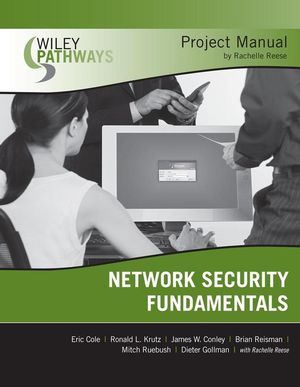|
Textbook
Wiley Pathways Network Security Fundamentals Project ManualISBN: 978-0-470-12798-8
Paperback
312 pages
July 2007, ©2008
 |
||||||
1. Computer and Network Security Principles
1.1. Identifying and Analyzing Risk 2
1.2. Installing Windows XP Professional 6
1.3. Installing Windows Server 2003 9
1.4. Using Microsoft Security Baseline Analyzer 13
1.5. Viewing Local Security Policy 18
1.6. Creating a Written Security Policy 24
2. Network and Server Security
2.1. Managing Server Roles 28
2.2. Managing Services and Ports 34
2.3. Using Network Monitor 38
2.4. Configuring Windows Firewall 42
2.5. Designing Border Security 45
3. Cryptography
3.1. Understanding Cryptography Concepts 48
3.2. Managing Driver Signing 49
3.3. Using Encrypting File System 53
3.4. Installing Certificate Services 57
3.5. Managing Certificate Authority Trusts 63
3.6. Requesting and Issuing Certificates 67
3.7. Revoking Certificates 70
4. Authentication
4.1. Comparing Credentials 75
4.2. Creating User Accounts 76
4.3. Configuring an Active Directory Domain Controller 82
4.4. Joining a Domain 89
4.5. Managing Password and Account Lockout Policies 93
4.6. Managing Authentication Protocols 101
4.7. Managing Logon Restrictions 103
5. Authorization and Access Control
5.1. Comparing Access Control Models 111
5.2. Managing Groups 112
5.3. Assigning Permissions 117
5.4. Troubleshooting Effective Permissions 125
5.5. Viewing User Right Assignments 129
6. Securing Network Transmission
6.1. Designing Network Perimeters 133
6.2. Implementing IP Address Filtering on IIS 135
6.3. Using IPsec Default Policies 139
6.4. Implementing Packet Filtering with IPsec 143
6.5. Implementing IPsec Encryption 150
7. Remote Access and Wireless Security
7.1. Understanding Remote Access Protocols and Wireless Security 156
7.2. Designing Remote Access and Wireless Access 158
7.3. Enabling Routing and Remote Access 160
7.4. Configuring a Dial-up Client 166
7.5. Configuring a VPN Client 171
7.6. Defining Remote Access Policies 176
8. Server Roles and Security
8.1. Using Default Templates 183
8.2. Creating and Applying a Baseline Template 188
8.3. Creating and Applying an Incremental Template 193
8.4. Securing DNS 197
8.5. Securing a File Server 203
8.6. Securing a Web and FTP Server 209
9. Protecting Against Malware
9.1. Identifying Malware 217
9.2. Comparing Antivirus, Anti-Spyware, and Anti-Malware Programs 218
9.3. Creating a Managed Computer 221
9.4. Securing Internet Explorer 224
9.5. Securing Outlook Express 232
10. Ongoing Security Management
10.1. Configuring Automatic Updates 237
10.2. Configuring Auditing 241
10.3. Using Event Viewer 245
10.4. Performing Remote Management with MMC 250
10.5. Using Telnet 256
10.6. Using Remote Desktop for Administration 260
11. Disaster Recovery and Fault Tolerance
11.1. Planning for the Worst 264
11.2. Responding to a Security Incident 270
11.3. Configuring Backups 272
11.4. Planning a RAID Configuration 282
11.5. Eliminating Single Points of Failure 284
12. Intrusion Detection and Forensics
12.1. Understanding Terminology 288
12.2. Comparing Intrusion Detection System Types 290
12.3. Investigating the Honeynet Project 292
12.4. Using Forensics Tools 294
12.5. Investigating an Attack 299



